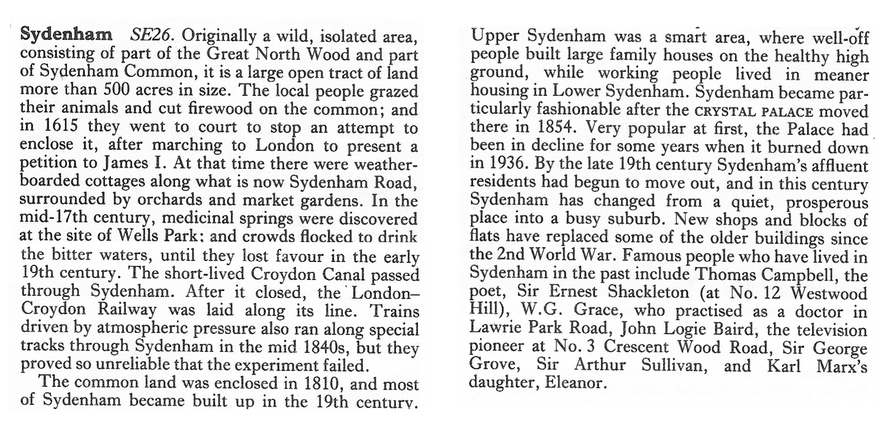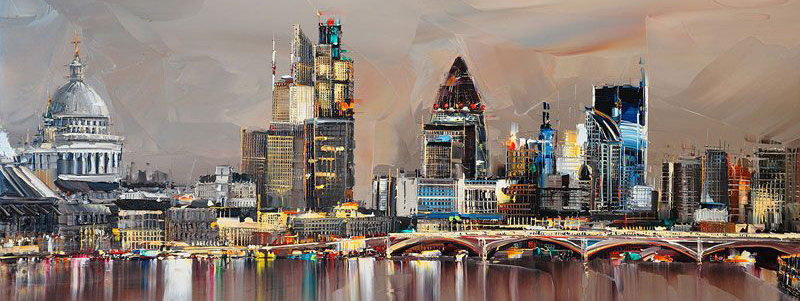Lewishham - Deptford - New cross - Sydenham
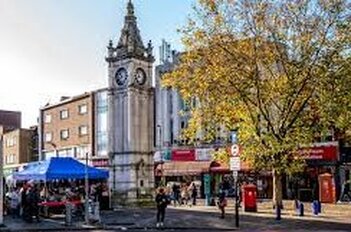 Lewisham, nestled in the heart of southeast London, boasts a rich history and a unique charm that sets it apart from its neighbours. With its Royal Docks, once part of Greenwich, and the River Thames flowing along its northern border, this area is bisected by the Prime Meridian of Greenwich, highlighting its central role in the London landscape. Legend has it that Lewisham's origins date back to the 4th century, when Leof settled here near the present-day St. Mary's Church, drawn by the drier land. Even in 1796, Daniel Lysons described the name "Levesham" - as it was spelled then - as "house amidst meadows," hinting at its idyllic location amongst verdant pastures. Founded at the confluence of the Quaggy and Ravensbourne rivers, Lewisham thrived as the marshy areas to the north were drained, allowing the village to expand in that direction.
Lewisham, nestled in the heart of southeast London, boasts a rich history and a unique charm that sets it apart from its neighbours. With its Royal Docks, once part of Greenwich, and the River Thames flowing along its northern border, this area is bisected by the Prime Meridian of Greenwich, highlighting its central role in the London landscape. Legend has it that Lewisham's origins date back to the 4th century, when Leof settled here near the present-day St. Mary's Church, drawn by the drier land. Even in 1796, Daniel Lysons described the name "Levesham" - as it was spelled then - as "house amidst meadows," hinting at its idyllic location amongst verdant pastures. Founded at the confluence of the Quaggy and Ravensbourne rivers, Lewisham thrived as the marshy areas to the north were drained, allowing the village to expand in that direction.Its motto, "Salus Populi Suprema Lex" ("The welfare of the people is the supreme law"), 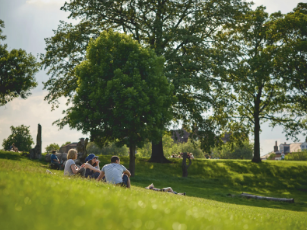 reflects the long-standing focus of its residents on the common good. Indeed, since Victorian times, Lewisham has been home to prominent sporting clubs, including the prestigious Cricket Club and the renowned Swimming Club, whose champions represented England in international competitions. An iconic symbol of Lewisham is its clock tower, erected in 1897 for Queen Victoria's Jubilee. Situated on the main road in the village centre, it has kept time for the residents for over a century, becoming an essential landmark. Lewisham is excellently connected by a network of roads, including the A20 to Dover and the A21 to Hastings. It boasts a large bus station and a major railway station, and is also the southern terminus of the Docklands Light Railway.
reflects the long-standing focus of its residents on the common good. Indeed, since Victorian times, Lewisham has been home to prominent sporting clubs, including the prestigious Cricket Club and the renowned Swimming Club, whose champions represented England in international competitions. An iconic symbol of Lewisham is its clock tower, erected in 1897 for Queen Victoria's Jubilee. Situated on the main road in the village centre, it has kept time for the residents for over a century, becoming an essential landmark. Lewisham is excellently connected by a network of roads, including the A20 to Dover and the A21 to Hastings. It boasts a large bus station and a major railway station, and is also the southern terminus of the Docklands Light Railway.
 reflects the long-standing focus of its residents on the common good. Indeed, since Victorian times, Lewisham has been home to prominent sporting clubs, including the prestigious Cricket Club and the renowned Swimming Club, whose champions represented England in international competitions. An iconic symbol of Lewisham is its clock tower, erected in 1897 for Queen Victoria's Jubilee. Situated on the main road in the village centre, it has kept time for the residents for over a century, becoming an essential landmark. Lewisham is excellently connected by a network of roads, including the A20 to Dover and the A21 to Hastings. It boasts a large bus station and a major railway station, and is also the southern terminus of the Docklands Light Railway.
reflects the long-standing focus of its residents on the common good. Indeed, since Victorian times, Lewisham has been home to prominent sporting clubs, including the prestigious Cricket Club and the renowned Swimming Club, whose champions represented England in international competitions. An iconic symbol of Lewisham is its clock tower, erected in 1897 for Queen Victoria's Jubilee. Situated on the main road in the village centre, it has kept time for the residents for over a century, becoming an essential landmark. Lewisham is excellently connected by a network of roads, including the A20 to Dover and the A21 to Hastings. It boasts a large bus station and a major railway station, and is also the southern terminus of the Docklands Light Railway.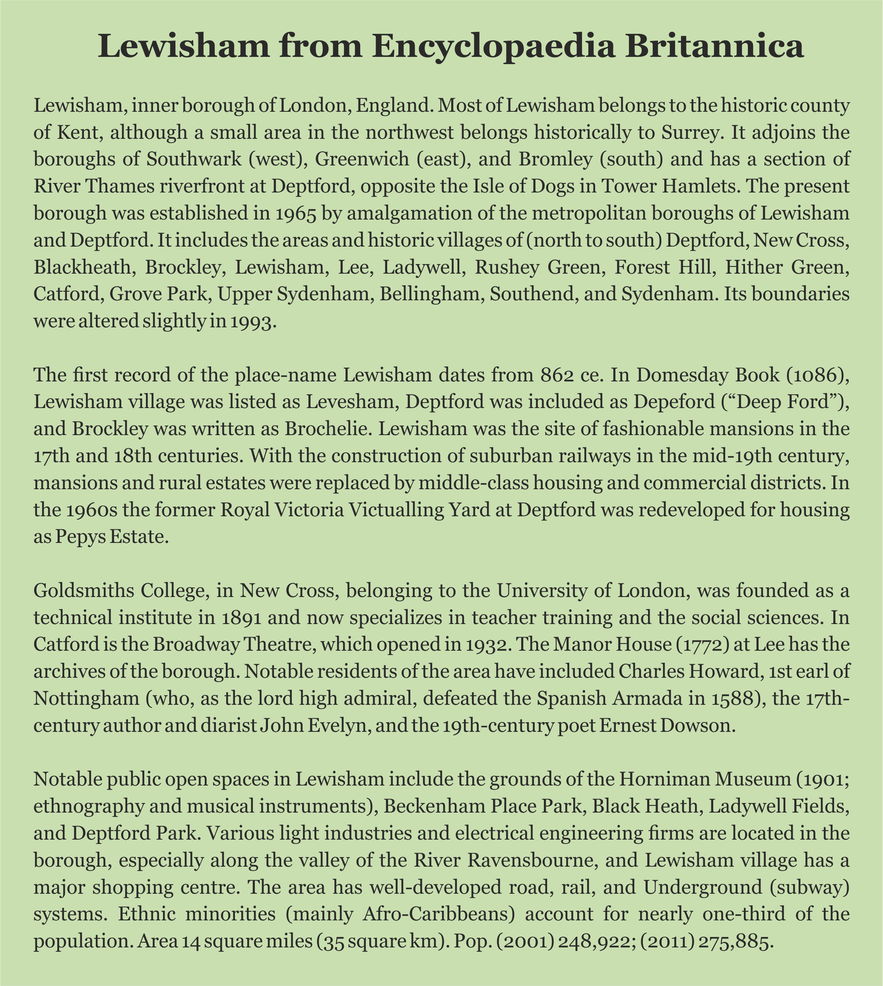
LADYWELL AND ST MARY THE VIRGIN CHURCH
HIGH STREET
TRAIN: LEWISHAM
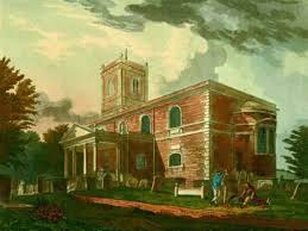 For at least a millennium, St. Mary's Church has served the people of Lewisham. Beside it stood an ancient well of healing water, Our Lady's Well, which brought fame to the village as a spa town since the Middle Ages. This well attracted numerous pilgrims and boosted the popularity of the church's services.
For at least a millennium, St. Mary's Church has served the people of Lewisham. Beside it stood an ancient well of healing water, Our Lady's Well, which brought fame to the village as a spa town since the Middle Ages. This well attracted numerous pilgrims and boosted the popularity of the church's services.The Lady Well, depicted in beautiful 19th-century lithographs like one by H. Warren, was a sacred well dedicated to the Virgin Mary. First mentioned in 1592, it dried up in 1855 due to the construction of sewers in Ladywell Road. Although gone, its capping stones have been preserved and arranged around a flowerbed, a lasting memory of its former glory.
On nearby Ladywell Road, one can find the ancient parsonage, built in 1693 by Reverend Stanhope, who later became the Dean of Canterbury. This house is a fine example of domestic architecture from that era. Stanhope was friends with Jonathan Swift, who often visited him here. The exact construction date of the church is unknown, but it is mentioned in a document from the year 1000. During the Middle Ages, it was a small building with a decorated ceiling and tiled floor. In 1881, it was expanded with the addition of a stone tower. The churchyard is rich in wildlife and features beautiful plants and interesting monuments, including the grave of poet Thomas Dermody. At number 48 Ladywell Road, one can find Café Oscar, known for its delicious French cheeses, quiches, and pâtés, best enjoyed with a good cup of coffee.
THE WATER TOWER
2, DRESSINGTON AVENUE
TRAIN: LADYWELL
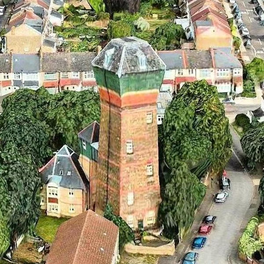 The elevated water tank was built in 1884 for the old baths on Ladywell Road. It is a tall, massive square tower made of red bricks with green and orange edges at the top. It features several clear windows, embrasures on the parapet, and a slate roof. The modern version of the old baths is represented by the Ladywell Sport Centre at 261 High Street. It offers a 35-meter swimming pool, several gyms, and other sports facilities. It’s also a great place to make a child’s birthday special and memorable, with pool games, roller skating, softball, cricket, and even mini-Olympics.
The elevated water tank was built in 1884 for the old baths on Ladywell Road. It is a tall, massive square tower made of red bricks with green and orange edges at the top. It features several clear windows, embrasures on the parapet, and a slate roof. The modern version of the old baths is represented by the Ladywell Sport Centre at 261 High Street. It offers a 35-meter swimming pool, several gyms, and other sports facilities. It’s also a great place to make a child’s birthday special and memorable, with pool games, roller skating, softball, cricket, and even mini-Olympics.FERRANTI PARK
LEWISHAM PARK
TRAIN: LEWISHAM
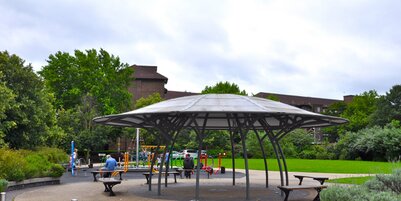 London’s parks are beautifully maintained thanks to a team of specialized gardeners who perform pruning, thinning, and the removal of diseased trees, among other tasks. Lewisham boasts several parks, including Lewisham Park along the borough's main road, featuring colourful flower beds, lush lawns, and a fountain. Although not very large, it is a pleasant place to stroll, especially in spring when the cherry blossoms are stunning. Slightly further south on Brownhill Road, you’ll find Mountsfields Park, which has sports facilities and hosts important cricket and rugby events. On nearby Wearside Road, where there was once a salt depot for gritting icy roads, lies Ferranti Park. Opened in 2004, it is dedicated to the talented engineer Sebastian Pietro Innocenzo Adhemar Ziani de Ferranti. Born in Liverpool to a photographer father and a pianist mother, Sebastian started inventing electrical devices as a boy and went on to design increasingly complex dynamos and electrical systems. In 1951, he created a computer prototype. One of his most significant works was the design of the Deptford power station.
London’s parks are beautifully maintained thanks to a team of specialized gardeners who perform pruning, thinning, and the removal of diseased trees, among other tasks. Lewisham boasts several parks, including Lewisham Park along the borough's main road, featuring colourful flower beds, lush lawns, and a fountain. Although not very large, it is a pleasant place to stroll, especially in spring when the cherry blossoms are stunning. Slightly further south on Brownhill Road, you’ll find Mountsfields Park, which has sports facilities and hosts important cricket and rugby events. On nearby Wearside Road, where there was once a salt depot for gritting icy roads, lies Ferranti Park. Opened in 2004, it is dedicated to the talented engineer Sebastian Pietro Innocenzo Adhemar Ziani de Ferranti. Born in Liverpool to a photographer father and a pianist mother, Sebastian started inventing electrical devices as a boy and went on to design increasingly complex dynamos and electrical systems. In 1951, he created a computer prototype. One of his most significant works was the design of the Deptford power station.ST STEPHEN’S CHURCH
HIGH STREET
TRAIN: LEWISHAM
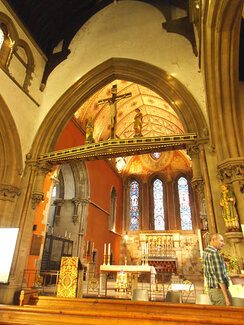 The late Victorian slate building with its beautiful façade was designed by George Gilbert Scott. It is located near the railway station, set back from the northern end of the main road. The interior is a blend of antique elements and modern artistic touches. This is a Catholic church where you can attend a Latin Mass, no longer celebrated in Italy.
The late Victorian slate building with its beautiful façade was designed by George Gilbert Scott. It is located near the railway station, set back from the northern end of the main road. The interior is a blend of antique elements and modern artistic touches. This is a Catholic church where you can attend a Latin Mass, no longer celebrated in Italy.The Mystery Worshipper - In London’s churches, there is a unique tradition of the "mystery worshipper," who has also visited here regularly. This worshipper attends Mass or service in disguise and then writes about the experience online under a pseudonym. The reviews cover the quality of the hymns, the organ music, the congregation's participation, and especially the sermon’s value. There are many mysterious worshippers scattered across London’s churches, and their reviews can be endearing or unusual. One of these recounted a dog sitting calmly through an hour-long sermon, while another complained about the coffee and cake served at the church being disgusting.
In front of the church, there is a lively open-air market. Behind the building, green paths lead towards Blackheath and Greenwich, offering a pleasant stroll through verdant surroundings.
The London Encyclopaedia
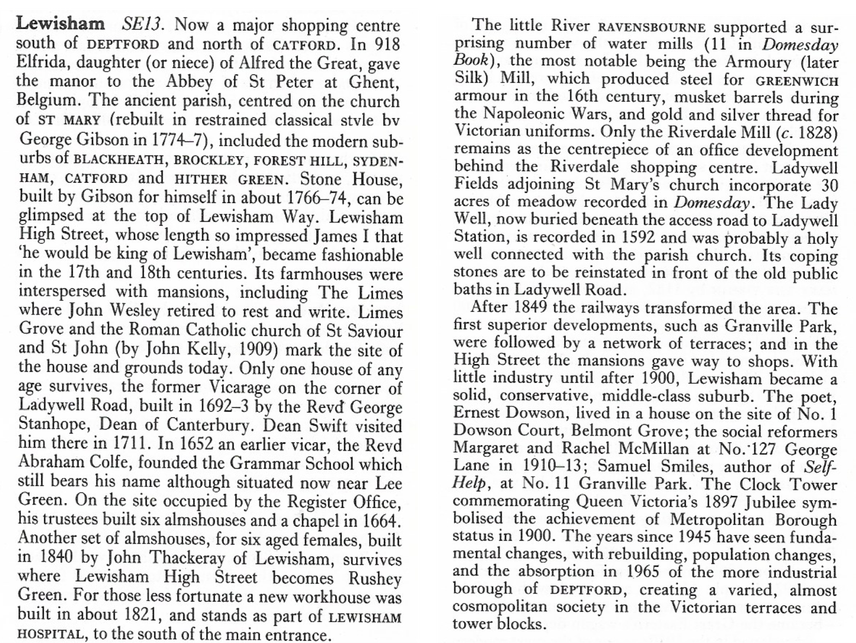
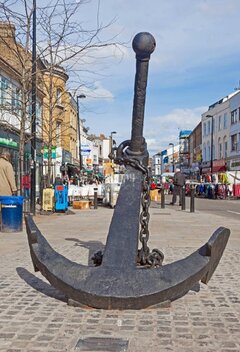 The name Deptford originates from "Deep Ford," referring to a ford on the Ravensbourne River. Its history began with a small cluster of houses built next to this crossing, where an ancient medieval path later became Watling Street, crossing the river. The pilgrim route to Canterbury also passed through this area. Initially, a wooden bridge replaced the ford, followed by a stone bridge.
The name Deptford originates from "Deep Ford," referring to a ford on the Ravensbourne River. Its history began with a small cluster of houses built next to this crossing, where an ancient medieval path later became Watling Street, crossing the river. The pilgrim route to Canterbury also passed through this area. Initially, a wooden bridge replaced the ford, followed by a stone bridge.For nearly four centuries, starting in 1550, Deptford hosted a Royal Dockyard, the largest shipyard of its time. It even attracted Peter the Great of Russia, who visited to study shipbuilding techniques. Deptford and its dockyards are also linked with the knighting of Francis Drake by Queen Elizabeth I on April 4, 1581, aboard the Golden Hind. Ships of the East India Company embarked from here for their trades in the East. Walter Raleigh also departed from here on his expedition for Elizabeth, as did James Cook on his third voyage aboard the Resolution. Unfortunately, ships loaded with slaves also departed and arrived here.
The famous Elizabethan playwright Christopher Marlowe was assassinated at Eleanor Bull's house in Deptford Strand, where he had spent the evening.
Strolling through the bustling market on Deptford High Street, held on Wednesdays, Fridays, and Saturdays, is a delightful experience. The market offers a range of goods from fresh fish to designer clothes, unusual jewellery to exotic food, all at low prices. Nearby Douglas Way hosts another equally fascinating market on the same days.
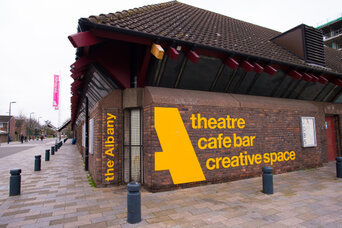 There is also the Albany Theatre, which was rebuilt in 1978 after a fire. It was Prince Charles who laid the first stone, and Princess Diana who inaugurated it. The theatre hosts performances and concerts aimed at combating racism. In the middle of High Street, near a tree, stands a large anchor symbolizing Deptford’s development and its strong connection to the docks and the sea. The railway station is one of the oldest in London.
There is also the Albany Theatre, which was rebuilt in 1978 after a fire. It was Prince Charles who laid the first stone, and Princess Diana who inaugurated it. The theatre hosts performances and concerts aimed at combating racism. In the middle of High Street, near a tree, stands a large anchor symbolizing Deptford’s development and its strong connection to the docks and the sea. The railway station is one of the oldest in London.ROYAL NAVAL DOCKYARD
TRAIN: DEPTFORD BRIDGE
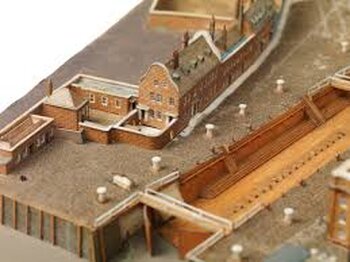 When Henry VIII established a shipyard here in 1513, the two small villages—one by the ford and the other a fishing village—began to develop rapidly. By the late 17th century, diarist John Evelyn noted that Deptford was becoming "almost as large as Bristol." Ships for the Royal Navy were built and repaired here. In 1514, Trinity House was founded to ensure navigation safety, named after the nearby Holy Trinity Church. Its first director was Thomas Spert, captain of the Mary Rose.
When Henry VIII established a shipyard here in 1513, the two small villages—one by the ford and the other a fishing village—began to develop rapidly. By the late 17th century, diarist John Evelyn noted that Deptford was becoming "almost as large as Bristol." Ships for the Royal Navy were built and repaired here. In 1514, Trinity House was founded to ensure navigation safety, named after the nearby Holy Trinity Church. Its first director was Thomas Spert, captain of the Mary Rose.In 1581, after circumnavigating the globe, Francis Drake moored his Golden Hind in Deptford. Queen Elizabeth boarded the ship to knight Drake and dine with him. Her order to preserve the vessel wasn’t followed, and all that remains of Drake’s ship is a chair, now in the Bodleian Library in Oxford, and a carved plank in the Hall of the Middle Temple. The last ship launched from this yard was a wooden corvette called Druid in 1869. The yard also served as the headquarters of the British Navy. Notable shipyards in Deptford included the Steam Navigation Company and Dudman's Arsenal, sometimes known as Deadman. The last dock, Convoys Wharf, closed in 2000.
For the next eight years, the site was owned by News International. Now there are plans to develop dozens of commercial buildings and residences on the former shipyard areas.
ONCE A WAREHOUSE, NOW A PARK
EVELYN STREET
TRAIN: DEPTFORD BRIDGE
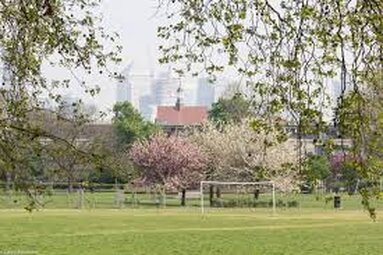 Originally, Deptford Park was an orchard. The land was later purchased by the family of the writer and diarist John Evelyn, who lived in the area. He donated it to the local administration to create a public park. The street running alongside the park is now named after him. Across from it, on Grove Street, is Pepys Park, dedicated to another diarist, Samuel Pepys, who was the Secretary to the Admiralty under Charles II. This site once housed the Royal Navy's large victualling yard. The warehouse had a nearly 500-meter-long facade and was the largest in the country, storing a variety of goods from biscuits and chocolate to mustard, pepper, tobacco, medicines, and uniforms. It also had bakeries and a slaughterhouse. This warehouse closed in 1961.
Originally, Deptford Park was an orchard. The land was later purchased by the family of the writer and diarist John Evelyn, who lived in the area. He donated it to the local administration to create a public park. The street running alongside the park is now named after him. Across from it, on Grove Street, is Pepys Park, dedicated to another diarist, Samuel Pepys, who was the Secretary to the Admiralty under Charles II. This site once housed the Royal Navy's large victualling yard. The warehouse had a nearly 500-meter-long facade and was the largest in the country, storing a variety of goods from biscuits and chocolate to mustard, pepper, tobacco, medicines, and uniforms. It also had bakeries and a slaughterhouse. This warehouse closed in 1961.A bit further south is the tiny Sayes Court Park, adjacent to the small square of the same name. You can enter from Sayes Court Street, a side street off Evelyn Street. One of Deptford’s notable houses, Sayes Court, stood here. John Evelyn lived there from 1652, having inherited it after marrying the daughter of Richard Browne. However the building was demolished in 1729 to make way for the victualling yard mentioned earlier.
ST NICHOLAS CHURCH
DEPTFORD GREEN
TRAIN: DEPTFORD BRIDGE
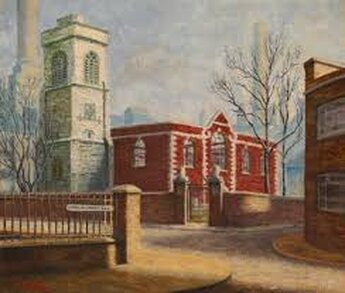 This riverside parish church dates back to the 1400s, though the current building is from the 17th century. Above the entrance gate to the cemetery is a row of skulls and crossbones. On the north wall, a plaque commemorates playwright Christopher Marlowe, who was killed at Eleanor Bull’s house on nearby Deptford Strand in May 1593 and was buried here in an unmarked grave.
This riverside parish church dates back to the 1400s, though the current building is from the 17th century. Above the entrance gate to the cemetery is a row of skulls and crossbones. On the north wall, a plaque commemorates playwright Christopher Marlowe, who was killed at Eleanor Bull’s house on nearby Deptford Strand in May 1593 and was buried here in an unmarked grave.Inside the church is a large canopy that was probably executed by Gibbons. He is also the author of some engravings depicting the visions of Ezekiel. Between them there are two dead heads, not really skulls, with holes in place of the eyes and nose and with hollowed cheeks. There is an anecdote about Gibbons and the historian Evelyn: one day, while walking, he had noticed the young artist engraving a bas-relief inspired by the Crucifixion of Tintoretto. Recognising the extraordinary quality of her work, Evelyn recommended it to the King and Wren. Gibbons is the author of the ornaments of many churches built after the Great Fire and was an important figure who influenced the development of wood and stone sculpture. Famous artists in Deptford included John Cleveley and his sons, who were marine painters and also worked at the docks as merchants.
CHURCH OF ST PAUL
DIAMOND WAY
TRENO: DEPTFORD BRIDGE
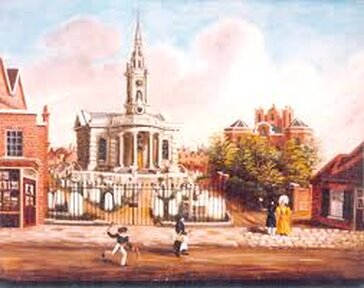 The small church is in a slightly elevated position, located on a side street of High Street, with steps flanked by a balustrade to reach it. It is a perfect Baroque building and, according to Pevsner, it is the English church that most closely resembles the Borromini and the Roman Baroque. The architect Archer, who designed it, has transmitted to the project his interpretation of the Roman baroque and his great desire for originality. The church was consecrated in 1730, after more than ten years of work. The interior is beautiful and theatrical, with gigantic Corinthian colonnades, decorated with stucco, and four private carved wooden fences, one in each corner. Above the Venetian window there is a trompe l'oeil curtain. Today the church is also used as an art center. There is an area dedicated to children, on whose red carpet they lay their shoes, before devoting themselves to the activities organized for them.
The small church is in a slightly elevated position, located on a side street of High Street, with steps flanked by a balustrade to reach it. It is a perfect Baroque building and, according to Pevsner, it is the English church that most closely resembles the Borromini and the Roman Baroque. The architect Archer, who designed it, has transmitted to the project his interpretation of the Roman baroque and his great desire for originality. The church was consecrated in 1730, after more than ten years of work. The interior is beautiful and theatrical, with gigantic Corinthian colonnades, decorated with stucco, and four private carved wooden fences, one in each corner. Above the Venetian window there is a trompe l'oeil curtain. Today the church is also used as an art center. There is an area dedicated to children, on whose red carpet they lay their shoes, before devoting themselves to the activities organized for them.ALBURY STREET
TRENO: DEPTFORD BRIDGE
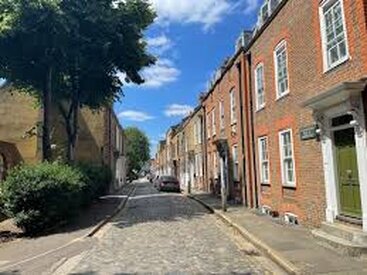 This street dates back to the early 18th century when it used to be called Union Street, commemorating the union of England and Scotland. The houses at the northern end of the street are original from the time when Deptford was a wealthy maritime centre. The houses have beautiful entrance halls with elaborately carved door frames. Cherubs, masks, and other grotesque figures, painted in white or black, support small canopies. These were the homes of shipbuilders and captains, while ordinary sailors lived in more modest wooden cottages. All would depart from Deptford for their long voyages. The lovely houses built by Thomas Lucas, who also constructed St John’s Church, have recently been restored. It's said that Nelson and his lover, Lady Hamilton, met in one of these houses, though there's no proof of this. At numbers 4 and 6 Union Street, there was a large pub called the King of Prussia, which was demolished to make way for new buildings.
This street dates back to the early 18th century when it used to be called Union Street, commemorating the union of England and Scotland. The houses at the northern end of the street are original from the time when Deptford was a wealthy maritime centre. The houses have beautiful entrance halls with elaborately carved door frames. Cherubs, masks, and other grotesque figures, painted in white or black, support small canopies. These were the homes of shipbuilders and captains, while ordinary sailors lived in more modest wooden cottages. All would depart from Deptford for their long voyages. The lovely houses built by Thomas Lucas, who also constructed St John’s Church, have recently been restored. It's said that Nelson and his lover, Lady Hamilton, met in one of these houses, though there's no proof of this. At numbers 4 and 6 Union Street, there was a large pub called the King of Prussia, which was demolished to make way for new buildings.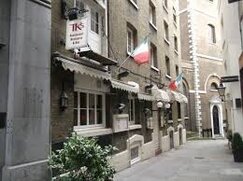 The curved street of Tanner's Hill, which intersects New Cross Road to the north and is partially pedestrianized, preserves some 17th-century houses and shops at numbers 19-31.
The curved street of Tanner's Hill, which intersects New Cross Road to the north and is partially pedestrianized, preserves some 17th-century houses and shops at numbers 19-31.These buildings are part of a conservation area and feature low, timber-framed houses that host traditional businesses, such as the Witcomb Cycles bicycle brand.
The London Encyclopaedia

The name "New Cross" comes from the area's complex web of railway lines, which earned it the nickname "New Cross Tangle." This was also the destination of London's last tram in July 1952. New Cross is associated with several tragic events. On November 25, 1944, a V2 rocket killed 168 people. On January 18, 1981, thirteen black youths died in a fire during a party at a house on New Cross Road. The suspicion of arson led to widespread public outrage.
In 1843, the Royal Naval School was established here to house the impoverished children of naval officers. Goldsmiths' College, located on Lewisham Way, is now part of the University of London. Its impressive building was designed by John Shaw.
HORNIMAN MUSEUM
100, LONDON ROAD
UNDERGROUND STOP: LONDON BRIDGE
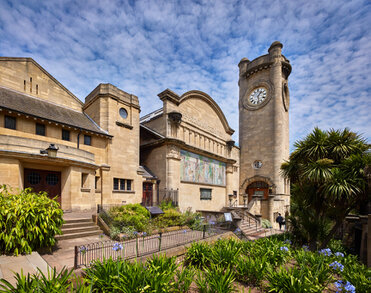 Frederick John Horniman, president of his family's tea importing company, amassed a large collection dedicated to ethnography and natural history during his lifetime. He initially opened it to the public in 1890 at his home, and then, in 1901, moved it to a purpose-built museum "dedicated to the public for its amusement, instruction, and enjoyment." The building, designed by C. Harrison Townsend, an Arts and Crafts architect, is in the Art Nouveau style, featuring a mosaic-decorated facade and a corner tower. The collection spans the entire evolution of animals, from fossil footprints to an iguanodon that roamed the mud in Swanage, Dorset, to a glass beehive. There are also curious animals, like the stuffed walrus. The taxidermists had never seen one before, so they overstuffed its skin, making it appear like a massive, unrealistic monster. Nevertheless, it was kept as a curiosity. Another oddity is a stuffed mermaid, created by combining a monkey and a fish. The collection includes Indian sculptures, magnificent
Frederick John Horniman, president of his family's tea importing company, amassed a large collection dedicated to ethnography and natural history during his lifetime. He initially opened it to the public in 1890 at his home, and then, in 1901, moved it to a purpose-built museum "dedicated to the public for its amusement, instruction, and enjoyment." The building, designed by C. Harrison Townsend, an Arts and Crafts architect, is in the Art Nouveau style, featuring a mosaic-decorated facade and a corner tower. The collection spans the entire evolution of animals, from fossil footprints to an iguanodon that roamed the mud in Swanage, Dorset, to a glass beehive. There are also curious animals, like the stuffed walrus. The taxidermists had never seen one before, so they overstuffed its skin, making it appear like a massive, unrealistic monster. Nevertheless, it was kept as a curiosity. Another oddity is a stuffed mermaid, created by combining a monkey and a fish. The collection includes Indian sculptures, magnificent  Benin bronzes, numerous African wooden statues, a life-sized statue of the goddess Kali, magical and ritual objects from various countries, including some Polish Christmas and Easter decorations. There are also five thousand musical instruments from all eras and parts of the world, and a collection of printed textiles, which can be viewed by appointment only to prevent fading. In 1969, an educational centre based on the collection's objects was opened. On clear days, the garden offers stunning views across South London and as far as Kent and Surrey.
Benin bronzes, numerous African wooden statues, a life-sized statue of the goddess Kali, magical and ritual objects from various countries, including some Polish Christmas and Easter decorations. There are also five thousand musical instruments from all eras and parts of the world, and a collection of printed textiles, which can be viewed by appointment only to prevent fading. In 1969, an educational centre based on the collection's objects was opened. On clear days, the garden offers stunning views across South London and as far as Kent and Surrey. An analemmatic Sundial - In the garden, there are several sun dials of curious shapes, forming the so-called Sundial Trail. Among them, there is a vertical one resembling a church window, a Roman one, a butterfly-shaped one, a bowl-shaped one, one with the letter "H" for Horniman, an equatorial one, and the particularly intriguing analemmatic sundial. This type typically features an eight-shaped hour line, with the time read at the point where the gnomon's shadow falls on the analemmatic curve. Here, it’s the visitor's shadow that tells the time; you simply stand on the current month, and the hour appears on the elliptically arranged slabs. The most unusual sundial is on the ceiling of the library and works with a mirror.
An analemmatic Sundial - In the garden, there are several sun dials of curious shapes, forming the so-called Sundial Trail. Among them, there is a vertical one resembling a church window, a Roman one, a butterfly-shaped one, a bowl-shaped one, one with the letter "H" for Horniman, an equatorial one, and the particularly intriguing analemmatic sundial. This type typically features an eight-shaped hour line, with the time read at the point where the gnomon's shadow falls on the analemmatic curve. Here, it’s the visitor's shadow that tells the time; you simply stand on the current month, and the hour appears on the elliptically arranged slabs. The most unusual sundial is on the ceiling of the library and works with a mirror.Standing at Ringmore Rise, a street of houses built in the 1930s just behind the museum, there is a beautiful view of central London.
The London Encyclopaedia
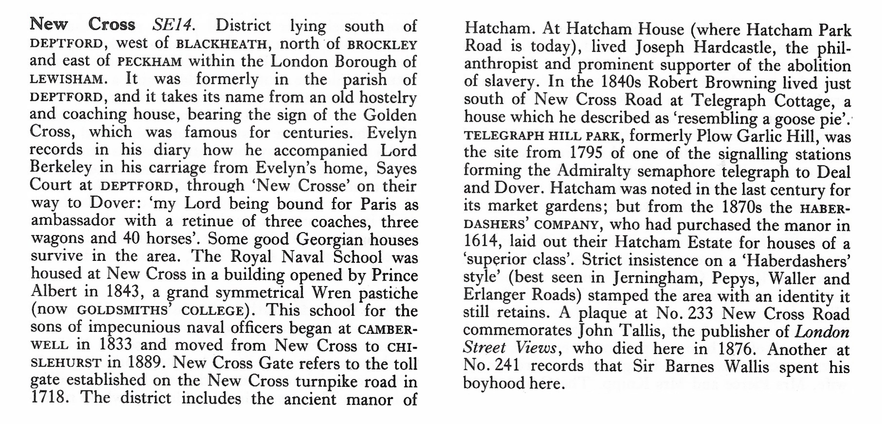
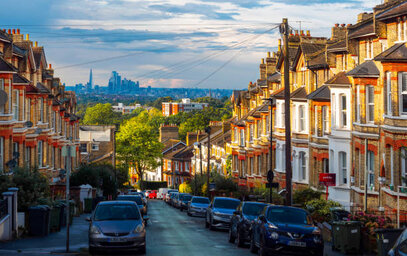 Today, Sydenham is mainly famous for being the relocated home of the Crystal Palace. However, in the 17th century, it was renowned for its therapeutic springs, discovered in what became Wells Park, which drew large crowds.
Today, Sydenham is mainly famous for being the relocated home of the Crystal Palace. However, in the 17th century, it was renowned for its therapeutic springs, discovered in what became Wells Park, which drew large crowds.The grand glass palace was originally built in Hyde Park for the Great Exhibition of 1851. In 1854, a private company bought the building, dismantled it, and rebuilt it in what was then called Sydenham Park, now Crystal Palace Park. The site hosted exhibitions, concerts, lectures, and sporting events until it burned down on November 30, 1936. These activities made Sydenham a fashionable area, supplied by gas from the Crystal Palace facilities. Significant population growth occurred in the 19th century after the construction of the canal. Notable residents included Antarctic explorer Ernest Shackleton, music dictionary author George Grove, and television inventor John Logie Baird. The houses along the hill roads around Sydenham Hill station exhibit a variety of styles from the early 19th century to today. The well-planned crest of the hill is particularly pleasant. Six Pillars, for instance, built in 1935 by Berthold Lubetkin on Crescentwood Road, is a villa in the spirit of Le Corbusier and features remarkable architecture.
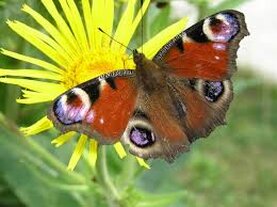 Butterfly Woods - Sydenham is an ideal place for a woodland walk. From the station, head north towards Dulwich Park, with its beautiful stone gate at the entrance. You can return to the station via College Road or Gallery Road, passing through Belair Park. Sydenham Woods is also known as "Butterfly Woods." Thanks to local volunteers, the number and variety of these colourful Lepidoptera continue to increase. In spring, the butterflies are especially enchanting.
Butterfly Woods - Sydenham is an ideal place for a woodland walk. From the station, head north towards Dulwich Park, with its beautiful stone gate at the entrance. You can return to the station via College Road or Gallery Road, passing through Belair Park. Sydenham Woods is also known as "Butterfly Woods." Thanks to local volunteers, the number and variety of these colourful Lepidoptera continue to increase. In spring, the butterflies are especially enchanting.At the end of Lawrie Park Avenue stands the 19th-century church of St Bartholomew, designed by Lewis Vulliamy, and featured in a painting by Camille Pissarro.
PREHISTORIC ANIMALS OF THE CRYSTAL PALACE
THICKET ROAD
TRAIN: CRYSTAL PALACE
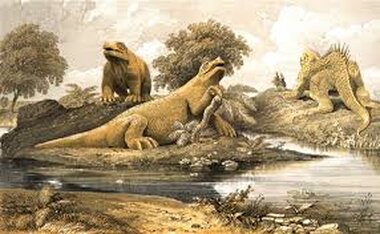 When the Crystal Palace was relocated here from Hyde Park, it was rebuilt even larger, with two tall towers designed by Brunel. Terraces and grand staircases with balustrades were added, leading to the large park and its ornamental lakes. Around these water features, amidst the trees and bushes, are various prehistoric animals created with an educational purpose in mind—to introduce the public to science through art. Originally, their arrangement differed from today's; they were grouped by periods—Palaeozoic, Mesozoic, and Cenozoic. The sculptures, crafted by Benjamin Hawkins in 1854, have undergone careful restoration and are now displayed without specific classification. These creatures, over 150 years old, form a sort of Jurassic Park, featuring iguanodons, ichthyosaurs, tyrannosaurs, brachiosaurs, and triceratops. Back then, to recoup some costs, small models of these animals were sold — a now common practice in museums, but quite novel at the time. It's a visit that delights children.
When the Crystal Palace was relocated here from Hyde Park, it was rebuilt even larger, with two tall towers designed by Brunel. Terraces and grand staircases with balustrades were added, leading to the large park and its ornamental lakes. Around these water features, amidst the trees and bushes, are various prehistoric animals created with an educational purpose in mind—to introduce the public to science through art. Originally, their arrangement differed from today's; they were grouped by periods—Palaeozoic, Mesozoic, and Cenozoic. The sculptures, crafted by Benjamin Hawkins in 1854, have undergone careful restoration and are now displayed without specific classification. These creatures, over 150 years old, form a sort of Jurassic Park, featuring iguanodons, ichthyosaurs, tyrannosaurs, brachiosaurs, and triceratops. Back then, to recoup some costs, small models of these animals were sold — a now common practice in museums, but quite novel at the time. It's a visit that delights children.PUNCH AND JUDY PUPPETS
CRYSTAL PALACE PARK
TRAIN: CRYSTAL PALACE
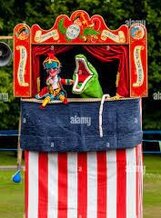 Another attraction that fascinates children is the Punch and Judy puppet show. The brightly painted wooden puppets of Punch and Judy today trace their origins back to Naples many years ago, during the Restoration. For decades, they have delighted the children of the capital, becoming more English than their original counterparts. Charles Dickens defended them against critics who argued their conduct was immoral, citing their roguish behaviour and tendency to flout the law as far from exemplary. You can also find them at Covent Garden.
Another attraction that fascinates children is the Punch and Judy puppet show. The brightly painted wooden puppets of Punch and Judy today trace their origins back to Naples many years ago, during the Restoration. For decades, they have delighted the children of the capital, becoming more English than their original counterparts. Charles Dickens defended them against critics who argued their conduct was immoral, citing their roguish behaviour and tendency to flout the law as far from exemplary. You can also find them at Covent Garden.SYDENHAM WELLS PARK
WELLS PARK ROAD
TRAIN: SYDENHAM
When it was discovered that the iron-rich, mineral-laden waters from the underground springs were beneficial to health, a spa was established here. Even King George III visited Sydenham to "take the waters." Today, the water from these springs feeds the ponds and streams that give the park its unique character and variety, allowing for the growth of plants that require particularly moist soil. The sculpture "Shepherd Boy" by Mortimer Brown adorns the park, along with the pink flamingos. The meadows are also dotted with wild rabbit burrows.
On March 25, 2005, the "Beast of Sydenham," a large animal nearly two meters long resembling a black panther, was sighted in this area. One night, it reportedly attacked a man in the park.
The London Encyclopaedia
